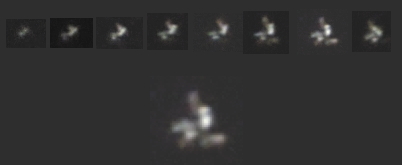
D7000 DSLR: ISS in 8" LX200-ACF
Posted: 7 June 2012
The eclipses and the Venus transit may be over, but the ISS is back in my night sky. Strong wind continued on Wednesday, 6 June 2012; gusts to 22mph. Opened the observatory at 1928 MST, 90°F. The wind was mostly gone. At 1954 MST, viewed Saturn, 77X. I then updated the TLE for the night's ISS pass. From 1950 MST to 2030 MST, I viewed Saturn at various magnifications. The view was excellent. Four moons were visible: Titan, Rhea, Dione, and Tethys (which was very close to the planet). I tried for Enceladus but was unsuccessful. At 2040 MST, viewed Omega Centauri globular cluster (almost due south) and then Centaurus A galaxy, 77X. Both objects are very low in the sky from Cassiopeia Observatory, but still nice to observe.
At 2045 MST, I began preparations for imaging the ISS. I mounted the D7000 DSLR at prime focus of the 8" LX200-ACF. Did a focus test exposure on the star Spica with the Bahtinov Mask, then locked the focus. Checked the finderscope alignment and made a couple of tweaks. At 2100 MST, I was ready for the pass, which was to begin at 2118 MST.
I picked up the ISS with my naked eye very low in the southwest just prior to the start of telescope tracking. Initial pointing was a few degrees off. But once I got the ISS centered in the finderscope, tracking was pretty good for the first half of the pass. Due to the sky darkness, it was difficult to see the finderscope crosshairs; got to get an illuminated crosshair finderscope one of these days. Since the pass would take the ISS near the North Celestial Pole (NCP), I was unable to monitor tracking when the finderscope got too close to the fork arm. And tracking was not too good near the NCP. So, I was not able to capture the ISS during the second half of the pass. This pass was not very high above the horizon, so the ISS was a long ways from me in line-of-sight and not very large. This image shows the ISS changing size, orientation, and brightness during the pass, as captured in the HD video, 1/2000sec, ISO 2000. The magnified view at the bottom is of the next to last image.

Closed the observatory at 2140 MST, 75°F.
Comments are welcome; use the Comments section below, or you can Email Me. Thanks.
Go to the previous report.
Return to the Cassiopeia Observatory Welcome Page.